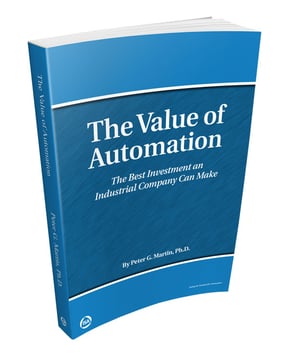This blog post was written by Villy Lindfelt, director of marketing & legal affairs at at Beamex. The post was written in conjunction with an ISA co-hosted webinar, featuring Peter G. Martin, Ph.D., vice president, business value solutions, Schneider Electric, and Alex Maxfield, vice president of sales and marketing at Beamex
An investment into calibration equipment and systems must be financially justified, just like any other business investment. But does a cheaper cost of purchase always mean a higher return on investment? Not necessarily. When building a business case for calibration system investment, what may seem at the outset to be cheaper may not necessarily be so, if the evaluation is made from total or lifecycle cost perspective instead of evaluating cost of purchase only.
Calibration system A can have a lower cost of purchase than calibration system B, but if calibration system B has better operational efficiency, the total cost of calibration system B can be lower than alternative A. The key point is to consider what elements form the total cost of implementing and running a system instead of focusing on isolated costs only, such as the purchase price of a calibrator or cost of a software license.
Why invest into a calibration system?
Your calibration system business case starts from defining a purpose. Why are you considering to make an investment into calibration? What value you are looking to generate for the company from the investment? Many times, a calibration system investment is competing with the same monetary resources as, for instance, a new building or renewing the company parking lot.
That’s why the evaluation should start from defining why you are investing into calibration. Some common reasons for making a calibration system investment relate to improving efficiency of the calibration process (e.g. time savings), boosting plant safety, enriching product quality through more accurate measurements, improving compliance with applicable standards and regulations as well as harmonizing calibration processes between different manufacturing plants of a company.
Compare total costs, focus on system lifecycle
When investing into a calibration system and building a business case for comparing alternative solutions, the nature of calibration activities as well as the lifecycle of the system and calibration process should be included in the equation. Purchase price as well as features and functions comparisons are important, but only a start and only a small part of the financial evaluation of different alternative calibration solutions. To put it short, there are basically three different cost generating elements related to calibration: equipment, labor and downtime (planned/unexpected). When trying to understand the total costs between different calibration system investments as well as the economic benefits related to the alternative investments, you can ask yourself:
- What are the implementation vs running costs of the system?
- What is the expected system lifecycle?
- What type of productivity benefits can be achieved (e.g. time savings, process improvements)?
- Does the system impact process downtime?
- What are the costs of maintaining the system?
- Does the system improve plant safety?
- Is product quality influenced?
- What is the estimated labor impact?
- Does the system impact risk mitigation and compliance?
Build for the complete lifecyle
The key element in creating a business case for calibration system is to build the business case for the entire lifecycle of the system and not just compare cost of equipment purchases and software licenses. Therefore, you should actually compare alternative calibration processes, and not the equipment as such. Consider what it means to implement and run a process with alternative equipment and have various viewpoints on this: financial, time-savings, risk mitigation, implementation/running/maintenance costs as well as headcount impact, among other things. 
Blog Posts
How Often Do Measurements Need to Be Calibrated?
Just in Time, or Just Too Late? A Kaizen Approach to Calibration
How to Improve Industrial Productivity with Loop Calibration
Temperature Calibration: Using a Dry Block to Calculate Total Uncertainty
How Can Advanced Calibration Strategies Improve Control Performance?
How to Calibrate a Pressure Transmitter
Webinar Recordings
Uncertainty in Calibration
Calibration Uncertainty and Why Technicians Need to Understand It
How to Avoid the Most Common Mistakes in Field Calibration
Learn Advanced Techniques in Field Calibration
How to Build an Industrial Calibration System Business Case
How to Use Calibration Tools for Accurate Process Temperature Measurement
How Does Low Flow Affect Differential Pressure Flowmeter Calibration?
Three Common Pitfalls of Pressure Calibration
Free Downloads
ISA Industrial Calibration Worksheets
Measurement Uncertainty Analysis Excel template plus book excerpt
Calibration Handbook of Measuring Instruments book excerpt
In-Depth Guide to Calibration for the Process Industries eBook
Calibration Uncertainty for Non-Mathematicians white paper
About the Author
Villy Lindfelt is director of marketing & legal Affairs at Beamex Oy Ab. He supervises the marketing team as well as focuses on contracts and documentation related to calibration system implementation projects. Villy joined Beamex in 2004. He has a master’s degree in economics as well as a master of laws degree.
About the Author
Peter G. Martin, Ph.D., is vice president of business value solutions for Schneider Electric. He holds multiple patents, including patents for dynamic performance measures, real-time activity-based costing, closed-loop business control, and asset and resource modeling. He authored or co-authored four books, most recently The Value of Automation. Martin received an ISA Life Achievement Award.
About the Author
Alex Maxfield, vice present of sales and marketing at Beamex, has more than 27 years experience as an engineer, with specialization in power generation, test and measurement instrumentation and quality mnanagement systems for production quality control. he has a business focus on enterprise-wide, multi-site calibration solutions.



